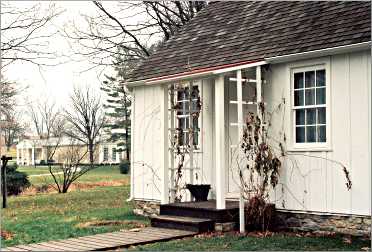West Branch's 'wonder boy'
A southeast Iowa town tells the story of Herbert Hoover, the international hero who became a scapegoat.

© Beth Gauper
Poor Herbert Hoover.
Orphaned at age 9, he spent his childhood picking potato bugs, weeding onions and cleaning barns. His first job after graduation from Stanford was shoveling ore.
Then he grew a mustache, bought a tweed suit and passed himself off as an experienced mining engineer. Sent to Australia at age 23, he found a vein of gold that yielded his London employers $65 million.
Sent to China at age 25, he built a port and modernized coal mines. In 1902, the San Francisco Chronicle called the blacksmith's son from West Branch, Iowa, the highest-salaried man of his age in the world.
Hoover traveled in Burma, Siberia, Egypt and Peru, amassing millions. By 1913, at age 39, his worldwide interests employed 175,000 men.
Then World War I came along, and the Great Engineer became the Great Humanitarian, orchestrating a complex rescue of 15 million children starving in Europe, often guaranteeing loans with his own fortune.
As Secretary of Commerce after the war, he championed the environment and streamlined government and industry. In 1927, traveled to the South to direct the color-blind relief of 350,000 people left homeless in a Mississippi River flood.
Calvin Coolidge derided him as "Wonder Boy." Franklin Roosevelt said of him in 1920, "He certainly is a wonder." Hoover was elected president in 1928 with the slogan "Who But Hoover?"
Eight months later, Wall Street crashed, along with Hoover's reputation, and the nation's idol became forever known as the man who ushered in the Depression.
It was the only problem Hoover couldn't fix.
Herbert Hoover was a heck of a guy, but he wasn't a politician.
He grew up in an area of southeast Iowa settled by people who put high value on moral virtue: Amish and Mennonites, who lived to the southwest around Kalona, as they do today, and German Inspirationists, who founded the Amana Colonies to the west.
Many Quakers lived in West Branch, which was a stop on the Underground Railroad, along with neighboring Springdale, where abolitionist John Brown planned his 1859 raid on the arsenal at Harpers Ferry, Va.
Hoover was born to devout Quakers in 1874. They lived in a two-room cottage and attended meetings at the 1857 Friends Meetinghouse, just across Wapsinonoc Creek.
Both still stand along Downey Trace, along a wide gravel path lined with trees and a boardwalk that connects five other historic houses. They include the 1872 home of Herbert's uncle Laban Miles, an Indian agent with whom the fatherless boy spent eight months on an Osage reservation in Oklahoma.
Around the corner stand the 1853 schoolhouse and a working reconstruction of Jesse Hoover's blacksmith shop. Across the creek sits the Presidential Library and Museum, and on a hillside are the graves of Hoover and his equally extraordinary wife, Lou.
Over the years, West Branch, just off Interstate 80 east of Iowa City, has flourished. In the mid-1980s, residents began to restore the handsome brick storefronts of downtown, 16 of which now are on the National Register of Historic Places.
Many house antiques shops, and a gazebo was built at the intersection of Downey Trace and Main Street, in memory of a two-level one that once stood in the middle of the street.
But the real draw is the excellent Presidential Library and Museum. Here, the story is told with oversized photos, videos and family memorabilia: There's young Bert, shipped to Oregon at age 10 to live with an uncle, two dimes sewn into his pocket.
There's Bert, posing in Australia with Aborigine prospectors, and Bert after World War I, persuading a Republican Congress to spend $20 million in famine relief for a Russia headed by Bolsheviks.
Videotaped interviews show that, for the people who were then children in Europe, this past is not far away: "To this day, I can feel the aroma of white rolls," says a Chicago chemist who ate "Hoover lunches" as a boy in postwar Germany. "That roll and hot chocolate, you remember that as long as you live."
Hoover's rehabilitation after his landslide defeat to Roosevelt in 1932 began after World War II, when Truman set him to work cajoling famine relief from seven kings and 36 prime ministers.
After that, he headed two commissions that reorganized the government.
When Hoover died in 1964 at 90, his reputation was largely restored. But he was still bitter. "Democracy," he said, "is a harsh employer."
Trip Tips: Herbert Hoover in West Branch, Iowa
Getting there: West Branch is 10 miles east of Iowa City in southeast Iowa, just off Interstate 80.
Herbert Hoover Presidential Library and Museum: It's open daily. Admission is $10, $3 for children 6-15.
Herbert Hoover National Historic Site: Admission is free to the Birthplace Cottage, Blacksmith Shop, Schoolhouse, Friends Meetinghouse, Gravesite and Tallgrass Prairie.
Events: First weekend in August, Hoover's Hometown Days, with craft demonstrations, games, music and fireworks.
Accommodations: Nearby Iowa City has many places to stay.
Information: West Branch.